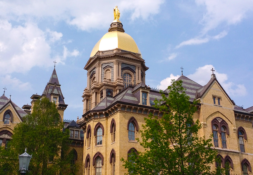And better reasons to go to Notre Dame
“In faith she entrusted herself to God without reserve and ‘devoted herself totally as the handmaid of the Lord to the person and work of her Son.’” – Redemptoris Mater, John Paul II
As the spring semester nears its midpoint, an ever-increasing stream of high schoolers and their parents arrive on campus. Admitted students receive a barrage of information from admissions workers, telling them why Notre Dame should be privileged with administering these four formative years of education.
Representatives from the Notre Dame admissions office likely posit a very diverse set of answers to the question, “Why Notre Dame?”—a required essay prompt for all Notre Dame applicants. This is understandable, for, even after spending multiple years studying here, it is not an easy question to answer.
In answering this question, undoubtedly, some students looked to the Notre Dame admissions website to discover how the institution views itself. But unfortunately, those who did so would have found very different answers than the predominantly Catholic atmosphere of the university might suggest.
In its own terms, Notre Dame distinguishes itself from its “aspirational peer” schools by its commitment to a “Spiritual Identity” that forms students to become a “force for good in the world.”
The university, however, misunderstands what “a force for good in the world” is, thereby undermining its very own “spiritual identity.” Notre Dame attempts to prove its spirituality in secular terms, reciting various community service statistics: “More than 80 percent of Notre Dame students participate in service or service learning before they graduate,” “Roughly five percent of each graduating class spends a year or more in volunteer service,” and “800+ Notre Dame graduates have served in the Peace Corps.”
While it is commendable that the university prioritizes service to others, these statistics are an unfortunate reduction of what it means to be a “force for good in the world.”
This metric minimizes the distinction between Notre Dame and the Ivy Leagues—what makes Notre Dame special in this case is merely its secular prestige. If Notre Dame is insufficiently spiritual—insufficiently Catholic, rather—then it limits possible answers to “Why Notre Dame?” to the all-too-familiar “it’s just the highest-ranked school I got into.” This need not be the case.
Students are welcomed to campus by Bl. Basil Moreau’s famous line “the mind will not be cultivated at the expense of the heart.” But this should not vacuously encourage students to merely become a “better person.” Rather, through a Notre Dame education, pupils should become like Christ in all things.
Spiritual identity is not equivalent to how many students volunteer on the weekends. It is more accurately equated to how many students graduate further along on their path to sainthood, having gained a greater intellectual capacity to pursue sanctity in their station in life.
Moreau understood the heart as the central mode of connection between God and man. The heart is the symbol of God’s love for man and man’s love for God, through which we may become like Christ. Moreau once charged his priests, “The sight of the Savior’s adorable heart should say to each one of us … ‘Look at this example and make a faithful copy.’”
Our Blessed Mother—depicted atop the golden dome and in numerous images around campus—perfectly conformed herself to Christ through her fiat and seeks to help us do likewise. She has faithfully copied Our Lord, her son, and she desires to help us be faithful imitators of him.
Mary, then, is the model of education. It is by her virginal gift of self that she came to possess completely her son and to be possessed completely by him. In her seven sorrows she joined perfectly in her son’s passion and fulfilled that vision of Moreau’s for his students “to become like Christ in all things.” She exemplifies the truest form of pedagogy, as she leads her children to the foot of the Cross to join in Christ’s suffering, thereby becoming like him.
Bl. Moreau’s vision for an institution that forms forces for good in the world means more than a vague attempt to become a “good person.” Rather, it is a call to conform ourselves to Christ as exemplified by Mary atop the Dome and in all the Catholic imagery around Notre Dame.
Our campus is architectonic. Students should be reminded of the ultimate purpose of our education every time we step into a classroom and see a crucifix on the wall. Likewise, the most iconic symbol of our university, the Golden Dome, presents us daily with a challenge to become like the one who watches over us, leading us to her son.
So, “Why Notre Dame?” Because Our Lady is central to the mission of the university. If this institution is to form its students to become “forces for good in the world,” namely saints, and to educate them in the truth, it must turn to the example of Our Lady, who was the primary educator of Our Lord, the one to whom we are to conform.
By embracing this tradition—this authentic spiritual identity—Notre Dame will set itself apart as the educational institution of our day and age. But it is only in this embrace of Bl. Moreau’s vision to form students to Christ that she will do so.
Elizabeth Hale is a junior studying political science and Italian. She wishes the admissions office would also emphasize the integral role that the God Quad squirrels play in the university’s prestige. To hear more, email ehale@nd.edu.
Photo Credit: Matthew Rice
Subscribe to the Irish Rover here.
Donate to the Irish Rover here.

